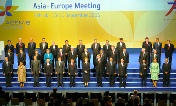What is ASEM?
ASEM is a cooperation forum for Asian and European countries. It was founded in Bangkok in 1996, with the aim of strengthening dialogue and interaction between the two regions, on the basis of an equal partnership. The Meeting offers leaders of many Asian and European countries (39 currently, including the 25 Member States of the European Union, the European Commission, 10 ASEAN countries and China, Japan and the Republic of Korea) a forum for the exchange of views and for cooperation in various fields. The cooperation takes place under three main pillars: a political pillar, an economic pillar and a cultural pillar.
Economic aspect
The driving force behind the ASEM process has been, as expected, economic cooperation, mostly due to the fact that the ASEM countries cover approximately half of the world’s GNP. The dramatic growth of Asia Europe economic relations and the increasingly protectionist approach of the EU against Asian goods gave a boost to the Summit’s economic talks.
European states focused on the promotion of trade and investment both ways while Asian states aimed at fighting European trade barriers and harmonizing procedures related to economic activities, mainly by supporting the WTO negotiations. In this regard, ASEM countries underlined that the Doha Development Agenda (DDA) must be complemented and supported to allow the negotiations to resume as soon as possible. On the EU trade barriers side, no official feedback has been released.
International security and the promotion of effective multilateralism are at the core of cooperation in the political field, with largely loose ties.
Political aspect
International security and the promotion of effective multilateralism are at the core of cooperation in the political field, with largely loose ties. The issues discussed included the never-ending-always-growing fight against terrorism, the better handling of global health risks (with the SARS outbreak being a recent proof of ineffective cooperation), the reform of the UN, organized crime, human rights (with a follow up to the Myanmar issue), and global environment challenges.
Results of the ASEM 6 Summit
In line with the Finnish Presidency’s green agenda, the Summit adopted a Declaration on Climate Change so as to strengthen the efforts to reach an agreement in international climate negotiations. The declaration supports the objectives of the United Nations’ Framework Convention on Climate Change and other measures to reduce greenhouse gas concentrations in the atmosphere. Matti Vanhanen, Prime Minister of Finland and current President of the European Council underlined that “This sends a strong signal to the world that ASEM intends to tackle the threat that climate change poses to sustainable development”.

The other declaration resulting from the Meeting, The Helsinki Declaration on the Future of ASEM, contains “guidelines and practical recommendations for developing cooperation in the future”. The uninspired document does little in way of adding and prioritizing work fields and targeting a closer and more effective bond between the two regions; it’s generally based on the ASEM principles of informality, networking and flexibility.
Several other ASEM-related events took place in the margins of the Summit, including cultural happenings to satisfy the needs of the third pillar, most of which went mainly unnoticed. They brought together representatives from limited Asian and European NGOs, labor organizations, media and business-life. The programme also included various cultural and other public events taking place in the unusually exciting Finnish capital.
Conclusion
The ASEM 6 Summit, attended by almost 1,500 delegates, was the largest ever in its history, though its results were not as historic. By the next ASEM Summit, to be held in Beijing in 2008, the number of cooperation partners will have increased from 39 to 45, with Bulgaria and Romania from Europe and India, Mongolia, Pakistan and the ASEAN Secretariat on the Asian side joining the ASEM process.

Follow the comments: |
|
